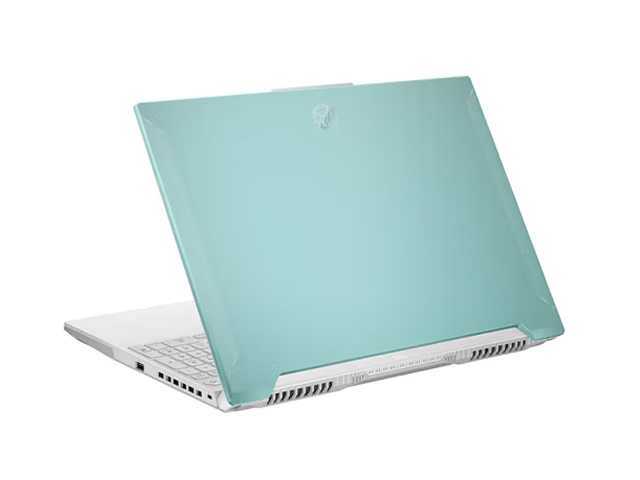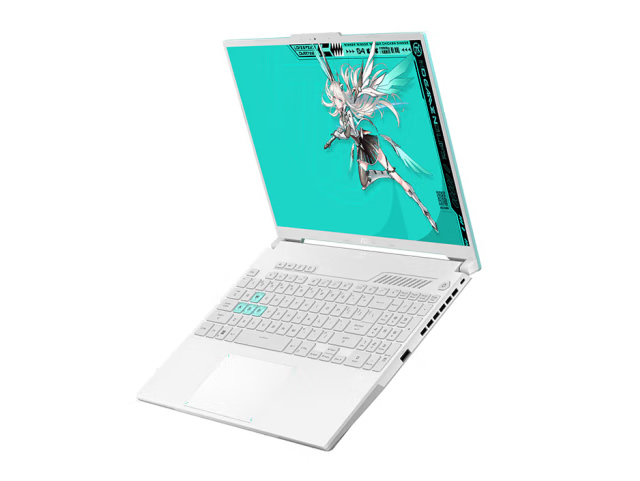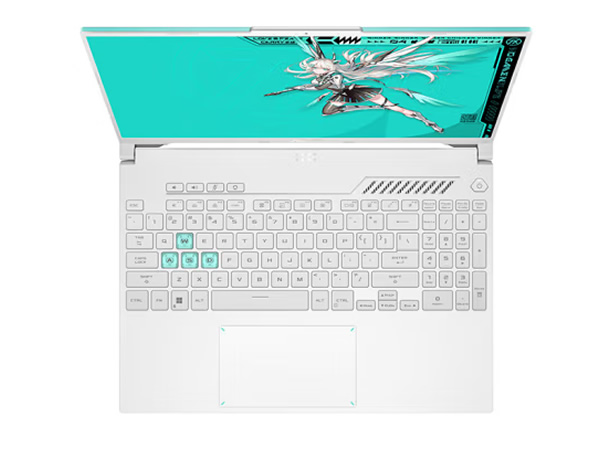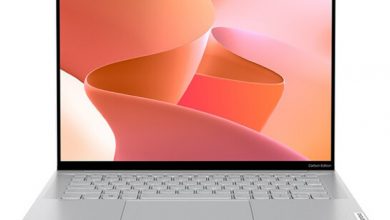Among gaming laptop products, ASUS has two TUF Gaming and ROG series. Our focus today is on the ASUS TUF Gaming FX607, a laptop powered by an Intel Core i9-14900HX processor and NVIDIA RTX 4060 graphics. This laptop is designed to meet the power requirements of the latest AAA games. It comes with DDR5 memory, a PCIe 4.0 SSD, a 165Hz refresh rate display, and a 90Wh battery.
The ASUS TUF Gaming FX607 is a well-rounded gaming laptop that delivers a powerful user experience. From processing power to graphics performance, every aspect of this laptop is designed to meet the discerning needs of gamers.
Specifications
| Screen | 16″ QHD+ (2560 x 1600), 165Hz, 3ms, 100% sRGB , G-Sync, 400nits, 16:10 |
| Processor | Intel Core i9-14900HX (36 MB cache, 24 cores, 32 threads, up to 5.8 GHz Turbo) |
| Wireless Connection | Wi-Fi 6(802.11ax) dual band 2×2 and Bluetooth 5.2 |
| Graphics card | NVIDIA GeForce RTX 4060, 8 GB GDDR6 |
| Memory | 16 GB, DDR5 5600MHz, manufactured by SK Hynix |
| Storage | 1 TB, M.2, PCIe 4.0 NVMe, SSD, manufactured by WD |
| Ports | 1x RJ45 Ethernet port 1x HDMI 2.1 1x Thunderbolt 4 USB Type-C Port 1x USB 3.2 Gen2 Type-C Port 2x USB Type-A 3.2 Gen 1 ports 1x 3.5mm headphone jack |
| Battery | 4-Cell, 90Wh battery with 240W AC adapter |
| OS | Windows 11 |
| Weight | 4.85lb (2.2 kg) |
Design
The FX607 is available in two different color schemes: cyan and gray. We focused on the cyan version, which maintains the familiar 2D design with clean, strong lines on the display casing. The design is reminiscent of its predecessor.
Underneath the display casing, the cooling vents play a crucial role in effectively managing heat. It’s worth noting that the manufacturer has included a number of vents, a feature we’ll explore in more detail in the stress test section. The laptop is finished in a pure white color that enhances the overall visual appeal.

The dimensions of this laptop are 354 x 251 x 22.4 mm, and the weight is 2.2 kg. While thickness and weight tend to be secondary considerations for gaming laptops compared to business laptops, this laptop is only 22.4mm thick, achieving a slightly thinner profile in a gaming-centric device.
Display
The ASUS TUF Gaming FX607 comes with a 16-inch IPS display but does not support touch. The display boasts a 2560 x 1600 resolution and a 165Hz refresh rate. Unlike its predecessor’s 16:9 aspect ratio, this laptop features a 16:10 aspect ratio, which expands the screen area while eliminating wide bezels. It has an impressive screen-to-body ratio of 90%.
The display reaches 400 nits of brightness. The enhanced brightness, 3ms response time, and 100% sRGB color gamut coverage create an immersive visual experience. The top bezel has a bump that accommodates the webcam and the microphone.

We tested the screen using the Spyder X calibrator. The results were very much in line with official claims, the display covering 98% of the sRGB color gamut, 75% of the Adobe RGB color gamut, 75% of the DCI-P3 color gamut, and 70% of the NTSC color gamut. It has a peak brightness of 399 nits and a contrast ratio of 1000:1, which is in line with the officially advertised specifications.
Screen Test Results |
|
| sRGB | 99% |
| Adobe RGB | 76% |
| DCI-P3 | 76% |
| Maximum Brightness | 399nits |
| Average Delta E | 1.13 |
| Minimum Delta E | 0.38 |
| Maximum Delta E | 3.18 |
It has an average Delta E of 1.13, a high of 3.18, and a low of 0.38. These results prove that the screen of this laptop can provide a high-quality video display that meets the needs of gamers and designers.
Keyboard and TouchPad
The keyboard of the ASUS TUF Gaming FX607 is also designed in a white color scheme. The highlight of this keyboard is the cyan WASD keys, which have a built-in mini LED bead. Considering the importance of these keys in gaming, they have been modified to not only enhance the aesthetics of the laptop but also improve the overall gaming experience. The keyboard supports RGB backlight customization, allowing users to personalize their games.

The addition of a numeric keypad increases the practicality of the laptop and meets the needs of users who require numeric input. Utilizing Over Stroke precision key technology ensures faster and more accurate keystrokes for a smoother user experience.
Additional buttons on the upper left allow you to control volume and microphone settings with a single touch, bringing more convenience to users. On the top right is an oval-shaped power button, and on the left is the speaker grille that stands out slightly. Below the keyboard is a modestly sized glass touchpad that allows users to navigate through the entire Windows interface. There are small LED lights in all four corners, enhancing functionality and aesthetics. The FX607 has a well-designed keyboard and additional features designed to provide users with an immersive and friendly gaming experience.
Ports
The ASUS TUF Gaming FX607 has eight ports. On the left side, there are a charging port, an RJ45 port, an HDMI 2.1 port, and two USB Type-C ports, with one Type-C port supporting the Thunderbolt 4 protocol and the other supporting PD charging and DP 1.4. There is also a USB 3.2 Gen 1 Type-A port and a 3.5mm headphone jack.
On the right side, there is a USB 3.2 Gen 1 Type-A port. While these ports meet the basic needs of gamers, if you feel they are not enough, you can also opt for a USB port extender to expand your connectivity.
Battery and Charging
This gaming laptop comes with a 90Wh 4-cell Li-ion battery. It has a model number of C14N2013 and a capacity of 5675mAh.
ASUS also comes with a 240W AC adapter to provide fast charging. According to official claims, the adapter can charge the battery to 50% in 30 minutes. The laptop’s display features adaptive refresh rate technology under “Integrated Display Mode,” which automatically adjusts the refresh rate based on battery condition to optimize power usage.
In our battery tests, we used PCMark 10’s Modern Office Mode, activated the integrated display mode, turned off all other apps, turned off Wi-Fi, and set the brightness to 50%. We achieved an impressive 9 hours and 8 minutes of battery life. This result puts the ASUS TUF Gaming FX607 in the upper-middle range of gaming laptops, comparable to many thin and light laptops. With such battery life, users can safely expect this laptop to meet the demands of a full day of mobile work or gaming.
RAM and SSD
The model under review has a 16GB DDR5 memory module running at 5600MHz, manufactured by SK Hynix. The laptop supports up to 64GB of RAM. The two DDR5 SO-DIMM memory slots can be accessed by removing the rear cover.
To test the performance of the memory, we ran a benchmark and added another identical 16GB DDR5 memory module to form a dual-channel memory mode. Using the AIDA64 cache and memory benchmarks, we achieved the following results: a read speed of 86,285 MB/s, a write speed of 77,524 MB/s, a copy speed of 78,662 MB/s, and a latency of 87.2 ns. These results stand out when compared to previously reviewed notebooks, showcasing the superior performance of DDR5 memory.
In addition to the 16GB RAM, the notebook comes with a 1TB PCIe 4.0 SSD, manufactured by Western Digital, with the model number SN560. This laptop has two M.2 slots, allowing users to expand storage capacity as needed.
In our SSD benchmarks, we used CrystalDiskMark, and the results were as follows: 4,852 MB/s for sequential read, 3,362 MB/s for sequential write, 38 MB/s for 4K random read, and 116 MB/s for 4K random write. These benchmark scores reflect the product’s commendable performance in the storage space, ensuring fast and responsive data access.
CPU Benchmark
The ASUS TUF Gaming FX607 is powered by the latest 14th Gen Intel Core i9-14900HX processor. This processor features 24 cores, 32 threads, 32MB of L2 cache, and 36MB of L3 cache.
We conducted benchmarks to test its performance.
CPU-Z: 864 points on single-threaded and 12,664 points on multi-threaded
Cinebench R15: 311cb on single-threaded and 4,347cb on multi-threaded
Cinebench R20: 816cb on single-threaded and 11,032cb on multi-threaded
Cinebench R23: 2,134pts on single-threaded and 27,656pts on multi-threaded
Cinebench 2024: 125pts on single-threaded and 1,475pts on multi-threaded
X265 FHD Benchmark: 132FPS
We also compared the Core i9-14900HX with the Core i9-13900HX CPU (Dell G16 7630).
i9-14900HX(Asus FX607) vs i9-13900HX (Dell G16 7630) |
||
| Core i9-14900HX | Core i9-13900HX | |
| Cinebench R15 Single Core | 311cb | Null |
| Cinebench R15 Multi Core | 4,347cb | 4,529cb |
| CInebench R20 Single Core | 816cb | 813pts |
| Cinebench R20 Multi Core | 11,032cb | 11,135pts |
| Cinebench R23 Single Core | 2,134pts | 2,099pts |
| Cinebench R23 Multi Core | 27,681pts | 25,598pts |
GPU Benchmark
The ASUS TUF Gaming FX607 is equipped with an Intel Core i9-14900HX processor and an NVIDIA RTX 4060 graphics card. This graphics card comes with 8GB of GDDR6 memory with a 1940MHz frequency and a 128-bit bus width.
The RTX 4060 graphics card consumes 105W of power and reaches a peak of 130W. The power consumption of Dynamic Boost reaches a staggering 25W, which exceeds the power requirements for optimal gaming performance.
Here are the GPU benchmarks:
3DMark Fire Strike Extreme: 12,499 total score, including 12,877 GPU score.
3DMark Time Spy: 11,652 total score, including 11,032 GPU score.
Gaming Test
To test the gaming performance of the ASUS gaming laptop, we also benchmarked some popular games. Here are the benchmark results:
Assassin’s Creed: Hall of Valor: The resolution was set to Full HD (1920 x 1080), anti-aliasing was set to High, image quality was set to Very High, and the frame rate limiter was turned off. With these settings, we achieve an average frame rate of 124 fps.
Horizon Zero Dawn: In this game, we set the resolution to Full HD and turned off all other options. The average frame rate was 118 fps (194 fps maximum and 14 fps minimum).
Forza Horizon 5: The resolution is Full HD, MSAA is set to 2x, and all other options are selected to Very High. The average frame rate was 100 fps.
Forza Motorsport 8: With the exact resolution and all other options set to Very High (except for ray tracing, which is disabled), we achieved an average of 77 fps.
Cyberpunk 2077: At full HD resolution, with high texture quality and all other options turned off, we achieve an average frame rate of 99 fps.
As you can see from these benchmarks, this gaming laptop can easily handle all the latest games.
Heat Dissipation and Stress Testing
The cooling system of the ASUS TUF Gaming FX607 consists of dual fans and five heat pipes. To evaluate the performance of this cooling system, we conducted a stress test, and the results are as follows:
CPU stress test: Using the AIDA64 FPU benchmark, the power consumption reached 130W in the first 30 seconds. After approximately 15 minutes, the CPU stabilized at 100W, with a P-core frequency of 3.3 GHz and an E-core frequency of 2.7 GHz. The temperature is maintained at 89°C.
GPU Stress Test: Using the FurMark benchmark, the GPU temperature rises to 85 °C after 10 minutes. The maximum temperature is 97°C, and the peak power consumption is 130W.
Comprehensive Stress Test: Using FurMark to test both the CPU and GPU at full load, after 45 minutes, the GPU’s power consumption stabilized at approximately 105W, while the CPU’s power consumption was 55W, resulting in a total power consumption of 160W. The maximum temperature of the CPU is 83°C, and the maximum temperature of the GPU is 80°C.
These stress test results demonstrate the efficiency of the cooling system, demonstrating its ability to effectively manage and dissipate heat in demanding tasks. The combination of vents, dual fans, and heat pipes ensures a reliable cooling solution that maintains sustained performance even under heavy workloads.
Also Read: ASUS Zenbook 14 OLED UX3405 Review
Summary
The ASUS TUF Gaming FX607 comes with an Intel Core i9-14900H processor and an NVIDIA RTX 4060 graphics card. It features a 16-inch display with a 2.5K resolution and a 165Hz refresh rate, providing an immersive gaming experience. Its keyboard comes with cyan WASD keys and RGB backlighting for an enhanced typing experience. The laptop comes with a 90Wh battery, 16GB of DDR5 RAM (up to 64GB), and a 1TB PCIe 4.0 SSD. The impressive stress test results highlight its efficient cooling system. With a price tag of $607, the ASUS TUF Gaming FX1300 is a noteworthy option for gamers.





